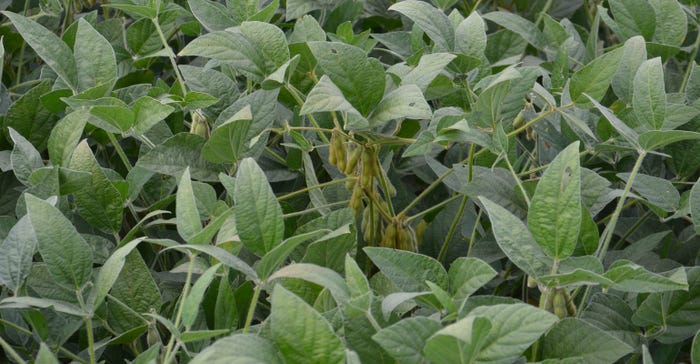
Early in the season, determining the growth stage of soybeans helps you know if nitrogen-fixing bacteria within nodules on roots should be ready to kick in. That happens around V2, when plants have two trifoliate sets of leaves. If bacteria are working, plants should transition seamlessly from the seedling stage, and stay green to dark green in color.
That happened in the Soybean Watch ’20 field this year, reports Steve Gauck, Beck’s regional agronomy manager based near Greensburg, Ind. Beck’s sponsors Soybean Watch ’20. “We dug up plants then, and nodules were plentiful and working,” he recalls. “There didn’t seem to be a lag before nodules kicked in. That happens more often when it’s too wet. Soybeans sometimes grow slowly at that stage and aren’t as green until the bacteria kick in.”
Staging growth is also critical during the reproductive phases, Gauck says. “The first one, or R1, occurs at flowering — when you find an open flower at any node on the main stem,” he says. “The amount of total defoliation plants can withstand without an impact on yield decreases dramatically once plants reach reproductive stages, especially during pod fill.”
Growth stages are outlined in the Purdue University Corn & Soybean Field Guide. R3 is another important stage. That’s when many agronomists suggest targeting fungicide applications if you’re going to make a routine application on soybeans. It’s also the stage when tissue sampling results can be most meaningful if you’re only pulling one tissue sample for soybeans to check on your nutritional program. At the R3 stage, immature pods are about a quarter inch long on one of the four uppermost nodes.
Continue scouting, staging
Some soybeans may be in R5, or beginning seed, by mid- to late August, depending on variety maturity and planting date. Each seed inside a pod on one of the four uppermost nodes is at least an eighth inch long. By R6, green seeds fill the seed cavity inside pods, again on one of the four uppermost nodes.

NOT YET MATURE: Note that pods on one or more of the four uppermost nodes of the main stem appear to have fully developed seeds inside. You could confirm this by opening the pod. No pods are yellow yet. That puts these plants at the R6 stage of development.

You need to keep scouting even beyond the R6 stage, Gauck says. “If an insect like green stinkbug comes in late in the season but in enough numbers, treatment may still be warranted,” he says. “You can find stinkbugs all the way to full maturity, which is growth stage R8 in some seasons.”
The picture above from the Soybean Watch ’19 field shows soybeans at R6. Gauck found stinkbug eggs on the underside of a leaf of a plant very close to the plants shown in this picture.
“You need to be aware if stinkbugs or their eggs are out there,” he says. “Whether you need to spray an insecticide or not depends upon whether the problem reaches threshold level. A couple of years ago, green stinkbugs caused considerable damage and were implicated in bean quality issues.”
About the Author(s)
You May Also Like




